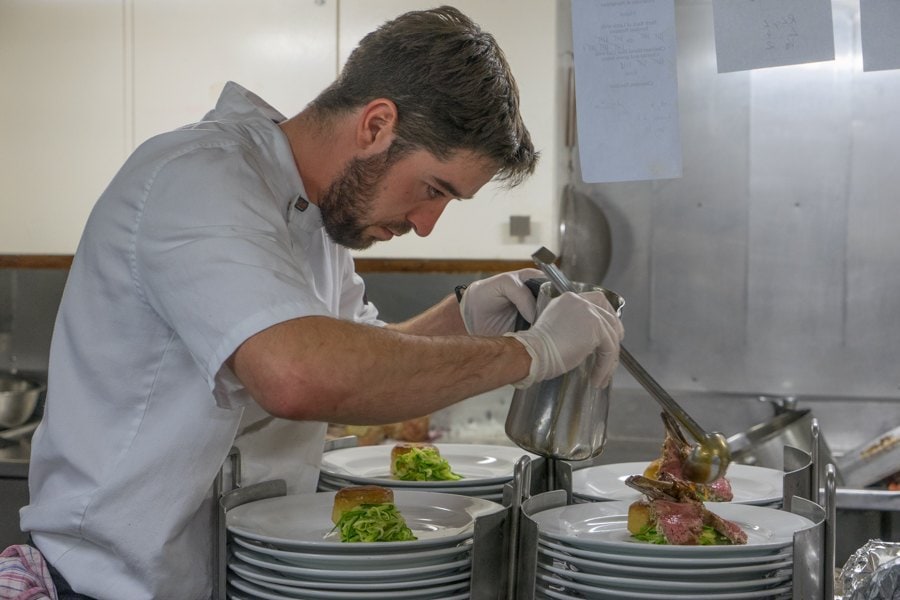
Crash! A pan slides off the counter, as Chef Max grabs at the air. He was one second too late to catch it as it went plummeting to the floor and the chopped veggies ended up all over the kitchen floor. I could see Max immediately go into ‘plan B’ mode. The ship was traversing through rough seas and if you take your eye off something for a second you may just lose it while cooking at sea.
Chef Ed places dollops of ice cream on the plate, but as he turns to get the pan of chocolate sauce the dollops are sliding back and forth on the plate like a couple of marbles- ruining his plating masterpiece. He had a moment of frustration as he tried to clean up the plate and then continued to meticulously pour the chocolate sauce over the top of the ice cream. “That’s just cooking on a ship,” Ed says. “Normally I wouldn’t be happy sending out a plate like that, but you can’t let it get to you when your kitchen is constantly pitching and rolling.”
Table of Contents
A Pleasant Surprise
As I spoke with the passengers on the ship, everyone set their expectations for rough seas on this voyage to Antarctica, however, they also set their expectations low for the food they expected to eat on the ship. It’s not a luxury cruise ship; it’s a tough, ice-strengthened Russian expedition ship – so most people expected pretty basic food for the month.
“Would you like the cod with chorizo green beans and sautéed new potatoes or the New Zealand rack of lamb with zucchini spaghetti and fondant potatoes?” Faye asked each person at the table.
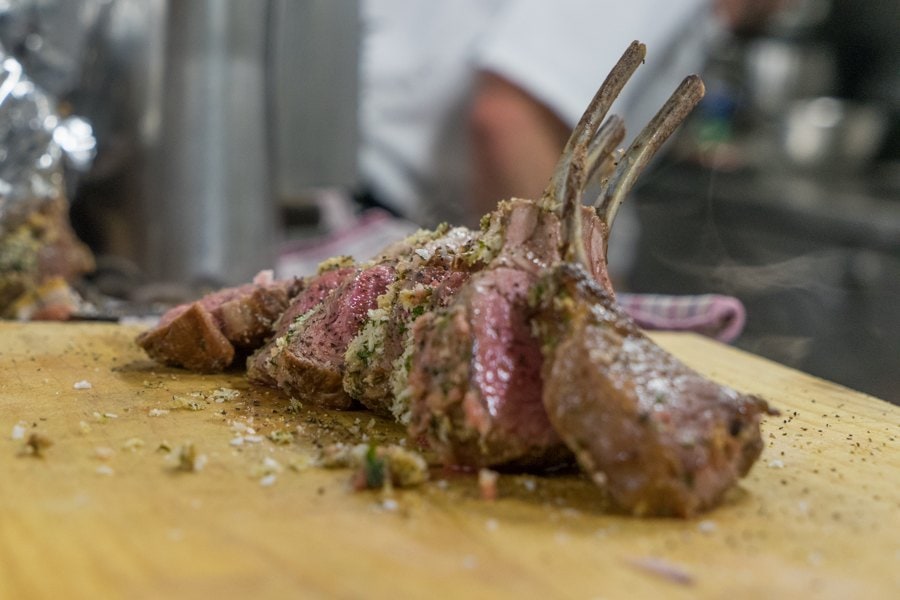
This clearly wasn’t ‘basic’ food. Each night we had a choice between fish and some sort of meat main dish, while people with special diets had slightly altered choices. Oh, and I can’t forget that we also had a starter and a dessert for each meal. That night Chef Ed made chocolate fondant for dessert – pure decadence on this small expedition ship.
Discover 7 things to do in Antarctica – that don’t involve wildlife
Shopping and Inventory Planning
For 30 days, Chef Ed and Chef Max prepared 3 meals a day on a small expedition ship traveling through the Southern Ocean with no chance to ‘run out to the market to pick up something they forgot’. Halfway through the trip, I asked each of them if they could go to the market and get one item right now and what would it be. Ed thinks a bit and says “Porridge. I’m worried we may run out for breakfast.” Max smiles wistfully and answers, “Fresh herbs. The herbs deteriorate quickly. We try to make them last as long as possible, using every part – stalks and all.”
Galley statistics from our voyage:
118 meals and 28 lunch sweets created
4480 eggs used
286 pounds of apples eaten
160kg flour used just for baking bread
I don’t know about you, but if I had to do the market shopping for this trip, I would’ve determined the menu and then built a ‘shopping list’ from that. However, Chef Ed has a different more meticulous process that ensures he doesn’t run out of what he needs when at sea. However, he may need to refine his algorithm for porridge it seems.
When ordering for the next trip, Ed takes inventory in the fridge and the storerooms regularly storing it in Excel. He then starts using that data to determine how many apples are used in a week. If we have a four-week trip, then he simply multiplies that by 4. And so on and so on for each item. “Then I add 10% on top of it,” he says with a grin like a true project manager hedging his bets and budget.
When placing a market/inventory order, he also takes into consideration the weather that we may be going through. “People eat more when the weather is good,” he explains. Since trips to Antarctica can be quite rough seas compared to their trips to Papua New Guinea.
As I learn more about his algorithm, it seems as complicated as Google’s search algorithm at times! But regardless he comes up with a giant grocery-shopping list for when they are in port – which isn’t very often!
Menu Planning at Sea
“We throw dish ideas at each other – and then go – we don’t have that, we can’t do that,” explained Ed. Menu planning is also a bit different on a ship as you can only use what you have on hand. They normally go about planning the menu the night before. It starts by looking in the fridge and seeing what things aren’t going to last the longest and planning something with that if possible. Then you have to look at the weather report and check sea conditions since some things don’t cook well on a day with lots of rocking and rolling.
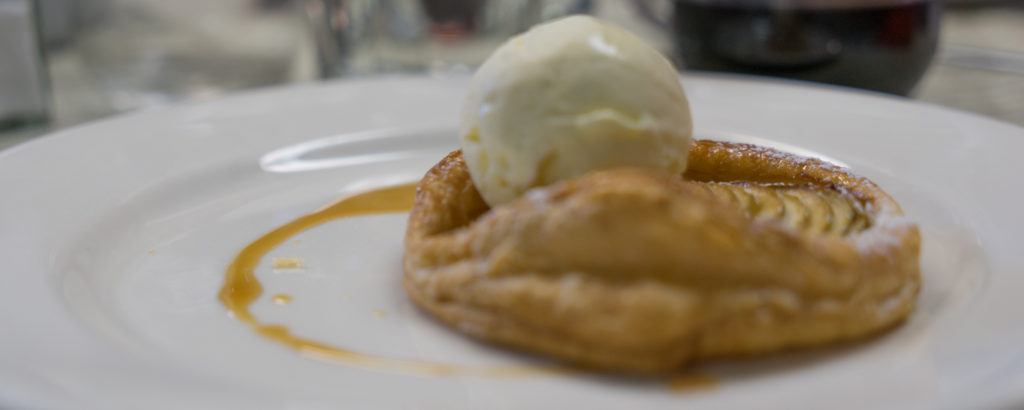
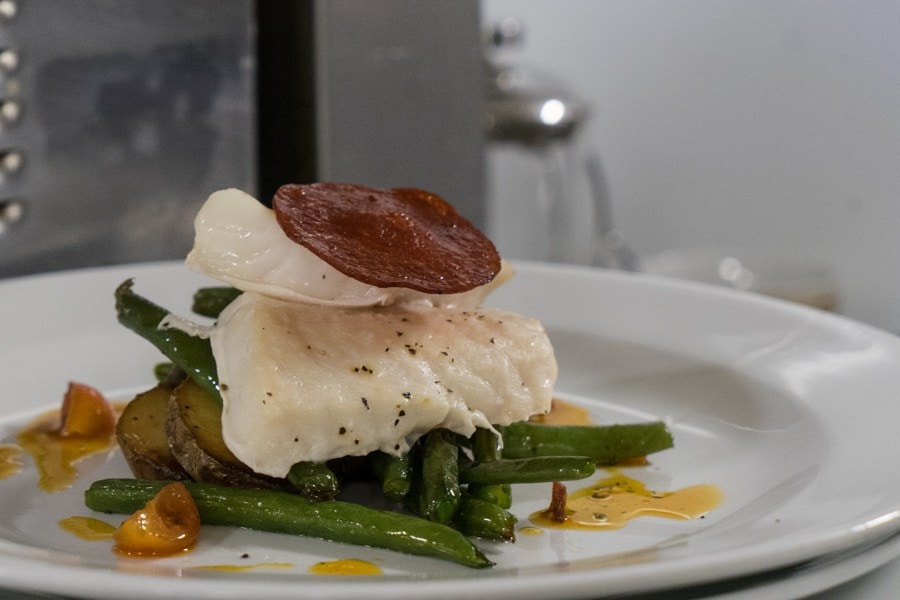
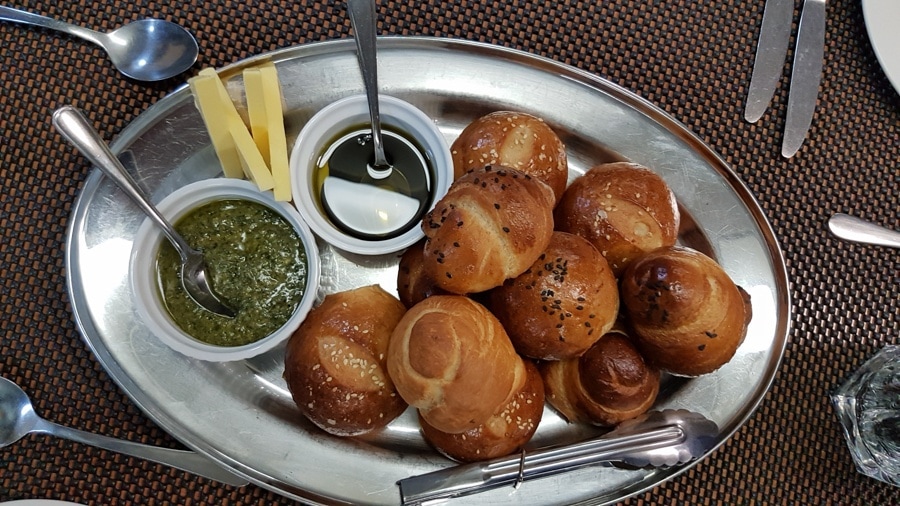
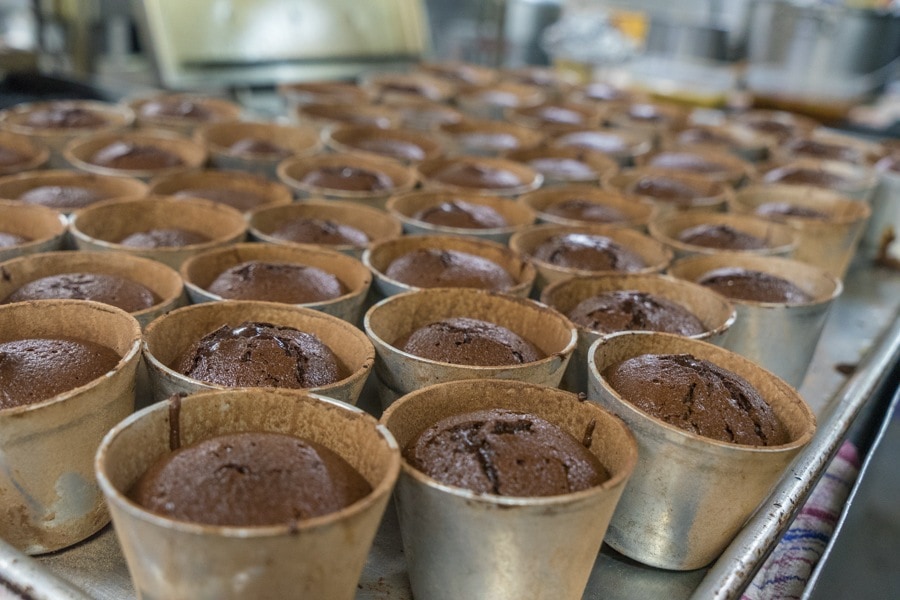
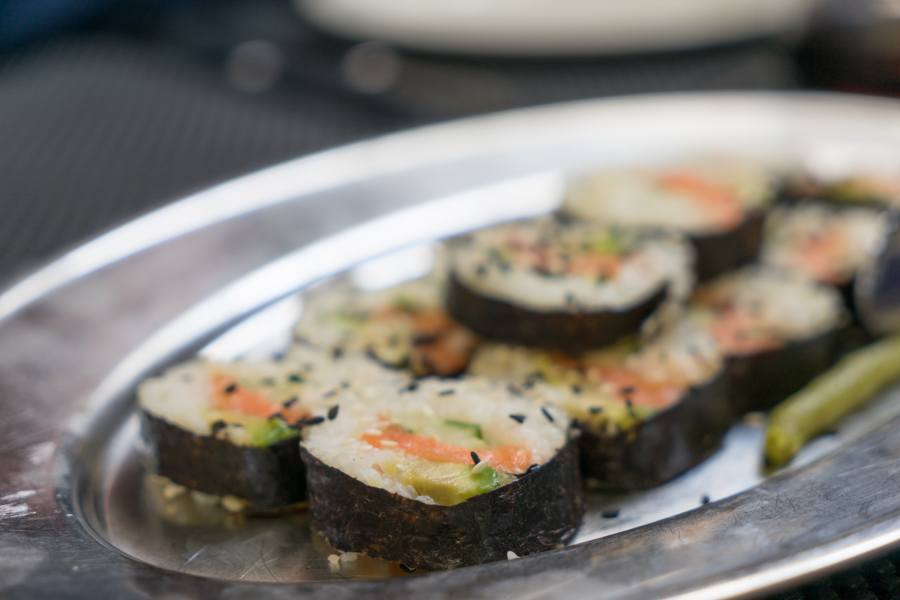
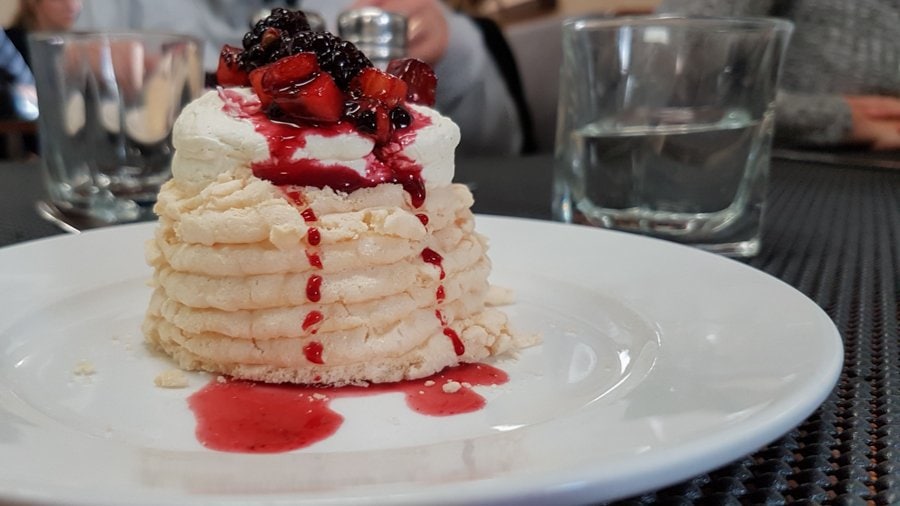

Cooking in an Undulating Environment
Watching the two chefs dance around each other, and hot kitchen appliances as the ship rolled back and forth unpredictably, was entertaining and nail-biting. It was as if I were watching a reality cooking show on the Food Network, drama, food, and emotions galore! I’d like to see Bobby Flay cook in the middle of the Southern Ocean in the Screaming Sixties with 12-meter swells and 30-knot winds. I’m pretty sure he’d probably lose to Chef Ed and Max as well as probably also ‘lose his lunch’!
“When it’s a real ‘rollie day’ there are only certain places where you can/should stand,” explained Max. If the ship is rolling, it’s easier to be parallel to the roll; widen your stance to remain stable. But it essentially cuts your work area in half in the kitchen if you can only stand parallel to the roll.
Chef Ed is not a novice at cooking at sea; he’s done 4 other trips with Heritage and has signed on for 9 more months of work on the ship. This is Max’s first time cooking on a ship. He took a risk when he said yes to working on the ship – he didn’t know if he would get seasick or not. Considering about half the passengers on the ship were seasick the first few days – it was a gamble for Max – and Ed.
Luckily, he faired well thanks to a cold air vent that he could stand under for the first few days! But it was a big learning curve for him. He said cooking on a ship was a lot like his first few years of being a new chef; lots of accidents, cuts, burns, and bruises. I did notice that he had his finger bandaged up the first few days; a potentially cruel initiation to the world of ship cooking.

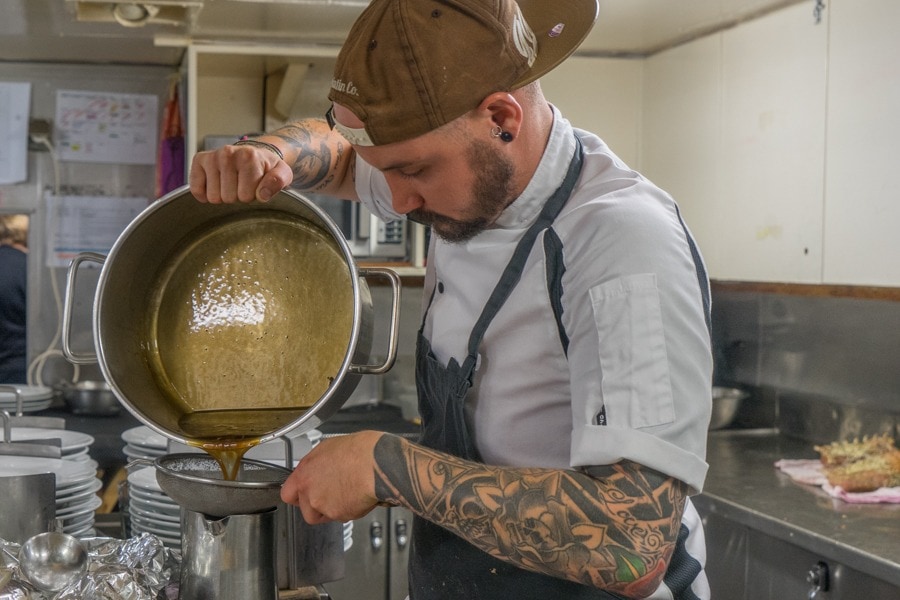
Days have to be really flexible to what’s happening outside; swells, whale sightings, and sometimes over the dinner hour it’s the only time you can do a landing due to weather windows. They have to be ready to push all meals forward or back at a moment’s notice.
The cooking is different too, “everything takes longer to heat up or boil. Things can take 3 times longer to cook on bad sea days,” explained Ed. Trying to boil a pot of water that is constantly swaying takes longer. Same with a pan, it’s moving off the heat with the sway of the ship. I learn they have to take all of that into consideration, as they prepare the dinners. Occasionally they do get ‘special treatment’ by the captain on particularly bad days so that serving and prepping is a little easier. “They change the angle of the boat for an hour or they will hold back for a bit,” Ed said, “which makes our lives a little easier. Plus, the staff always pop their head in to see if we need any help. Everyone pitches in.”
Galley Feng Shui
This is an older research ship turned cruising ship, so admittingly the kitchen isn’t a state-of-the-art ship kitchen. However, it has the basics. The stove has ‘railings’ for all of the pots preventing a pot of scalding hot water from sliding off the stove. There is also a rail on the ceiling that runs around the whole stove and center cooking area for the chefs to grab onto and steady themselves. “This thing is a lifesaver,” said Ed as he stirs with one hand and holds on to the railing with the other. “It’s practice for if I ever lose an arm – I can still cook!” Max said while holding onto the railing above the stove while the ship swayed and he grilled up a rack of lamb.
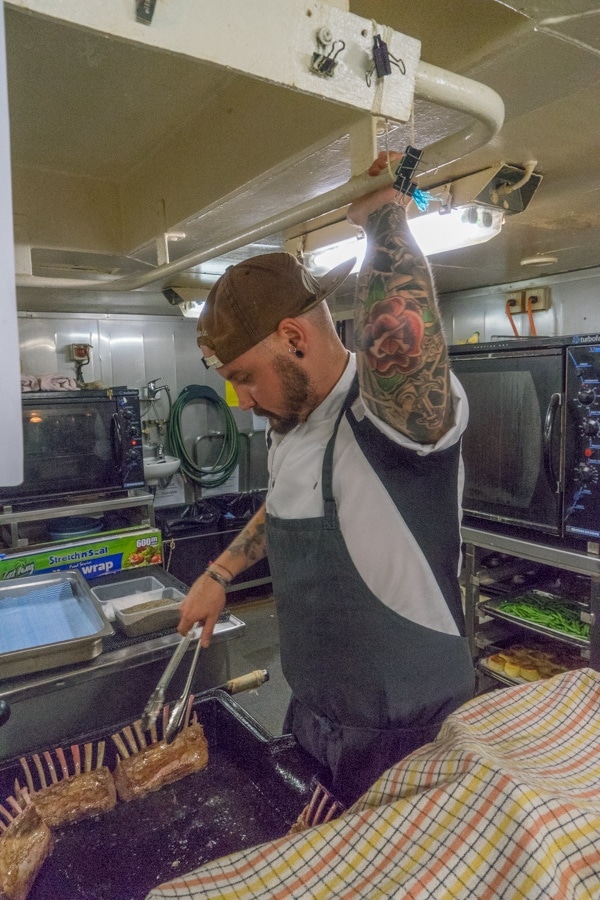
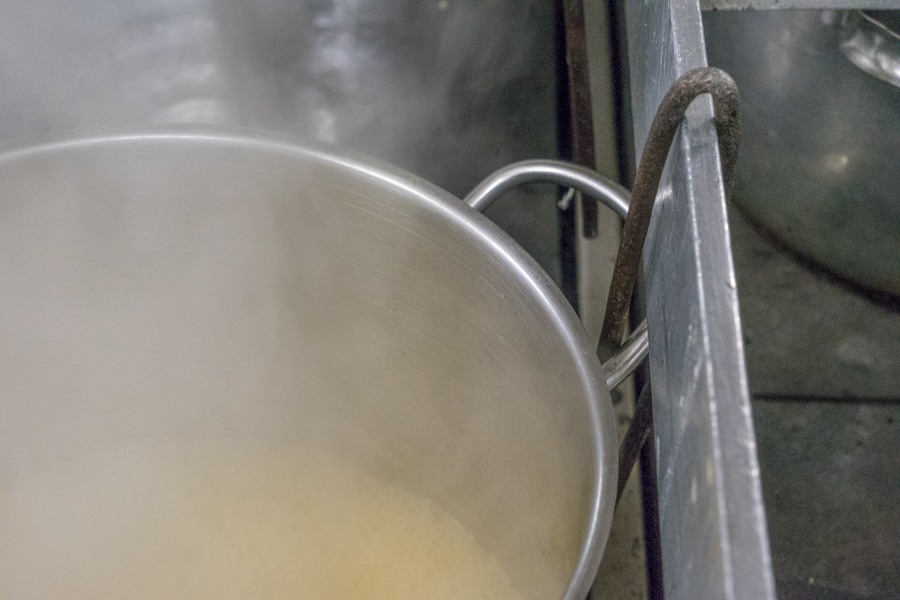
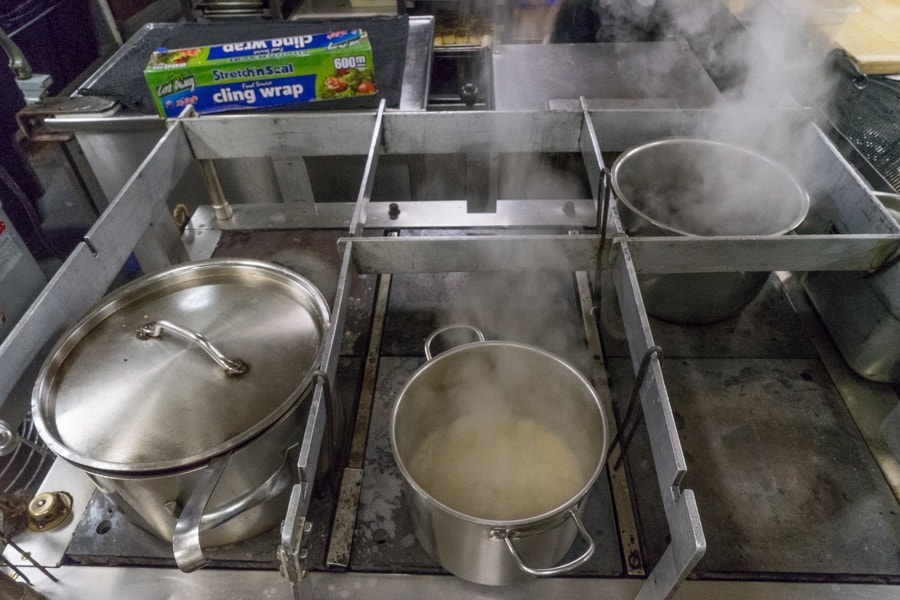
Most of the counters have one-inch ‘rims’ so things don’t slide off, and most of the counters also have the elephant skin, a non–slip counter cover, to keep things in place. However, not all of them have the ‘skin’, which led to the initial crash that left Max lurching a second too late as the pan of veggies hit the floor.
The Art of Plating at Sea
One would think in this environment elegant plating might go by the wayside, but each night another elegant plate came out of the kitchen without a crumb on it in the wrong place.
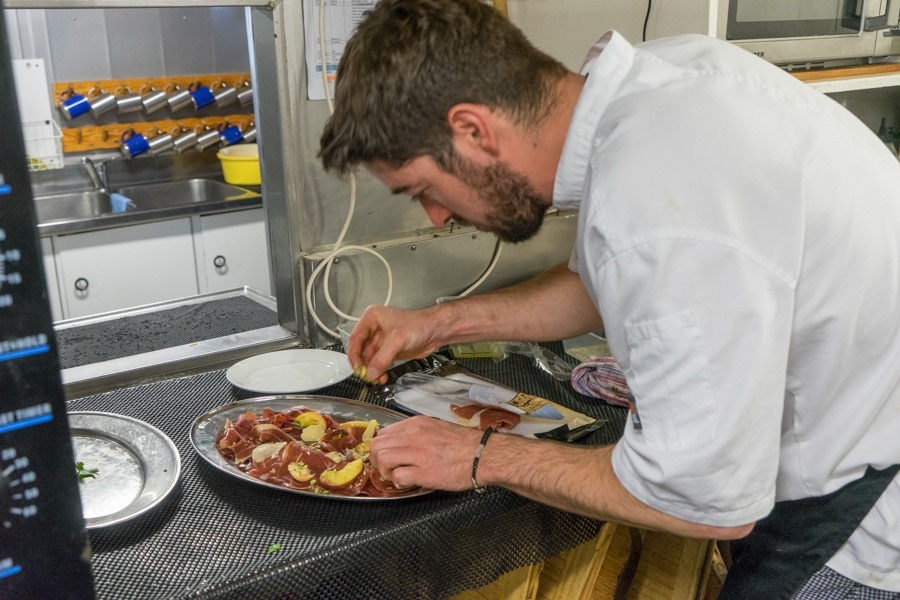
Back in the kitchen, I watched as Ed and Max worked out every little detail of how they would plate the 170 dishes that go out every night. They have to make concessions at times due to inventory, such as leaving the orange wedges off the chocolate fondant because they are low on the fruit inventory. They also have to leave a few things to chance like how the ice cream will plate in a moving environment. “We’ll just wait and see how it goes,” Ed said to Max regarding the dessert plating strategy for the night. ‘Wait and see’ is something you never hear said in a regular restaurant kitchen! But, flexibility is key in the galley kitchen!
The Perks of Being a Ship Chef
Luckily the chefs are not only confined to the kitchen, they too get to go out on landings and zodiac cruises with the passengers. In fact, that’s one of the main draws for doing this hard work 12 hours a day for a month with no days off. You actually get to go to Antarctica! For both Ed and Max, this is their first journey (of many) to Antarctica and they are enjoying every moment they can to get out to see the wildlife and experience the vastness of the place.
“I was always told that being a chef could take you anywhere, but I didn’t think I’d be in Antarctica. But it literally can take you anywhere,” said Max with a grin.
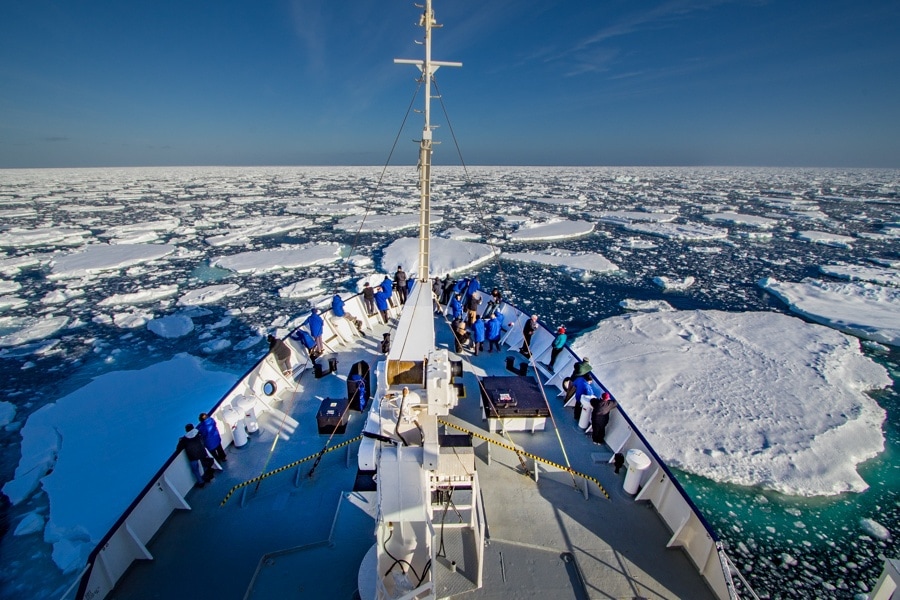
Not only does being a chef on an expedition ship take you anywhere, much like NYC, if you can cook here, in the Southern Ocean, you can cook anywhere…
How to get to the Ross Sea Antarctica
Heritage Expeditions is one of the few companies that offer expedition cruises into the Ross Sea. This small family-owned company has been doing it the longest and knows the area better than anyone. I cruised for 28 days on the Wake of Scott and Shackleton Itinerary.
See my Ultimate Antarctica Packing List
Antarctica packing is much more than just ensuring you have warm clothes! Before you go, make sure you have all of these Antarctica items!


By Lucy crossfield March 27, 2017 - 8:26 am
A nice read. I spent 5 years on yachts and had the best time of my life. I guess i was spoiled as they were private and only sailed when the weather was flat calm. A couple of rough days crossing the atlantic but i do remember the french chef and his temper. Always calmed down with a sneaky cup of pastis from me. Enjoying your blog by the way. Xx
By Sherry March 27, 2017 - 10:01 am
I love it! Pastis always helps!
By Erin Southerland March 27, 2017 - 9:18 am
This is so interesting to learn about! And the food is so different from the cream chip beef my grandfather made as a Navy cook, no need to learn the art of playing in his galley.
By Sherry March 27, 2017 - 9:59 am
Ha! I bet your grandfather never had to worry about plating! Actually I felt like these chefs went above and beyond in that capacity…no matter what the weather they still put together these creative plates – just amazing!
By DAD March 27, 2017 - 3:40 pm
Sherry,
I cooked breakfast eggs on a troop ship in the north Atlantic going to Germany in January 1956. We hit some very rough seas 3 days out of NYC. We had 3 grills each with 12 egg skillets on them. The skillets went from one grill to the other as there was no barrier between them. I was on the center grill and we just picked a skillet as they came by us. Needless to say there was no fancy plating going on in that mess hall. Mess was really the word for our breakfast that morning, but who cared as 90% of the troops were seasick and not eating anyway. I was not one of the 90% Probably because of the fresh air pipe just above our grills. That trip was an adventure to say the least.
DAD
By Sherry March 28, 2017 - 1:48 pm
So that’s where you learned how to make scrambled eggs! I think having something to focus on, like a task, does help ward off sea sickness a bit. And why didn’t I inherit your sea legs?
By Susan Stephens March 27, 2017 - 7:55 pm
Fascinating – I love this article! It seems that Chef Max and Chef Ed require an “anything goes” attitude to have to put up with all of that. That food looks AMAZING.
By Laura March 28, 2017 - 1:33 am
Wow, you are not just kidding. If they can cook in that environment, and plate beautifully, they can do it anywhere. That’s truly impressive!
By Alanna March 29, 2017 - 9:02 am
What an extreme job … being a chef is tough enough under normal conditions!
By Sherry March 30, 2017 - 11:31 am
Good point! I couldn’t have cooked those dishes on stable ground either!
By Henry May 23, 2017 - 9:07 am
What a cool view into an under-appreciated part of the cruise community! I spent six weeks working on a research ship in Antarctica a few years back, and our chefs didn’t put nearly that type of effort into the plating! There’s something to be said for a luxury vs working trip sometimes. Thanks for sharing!